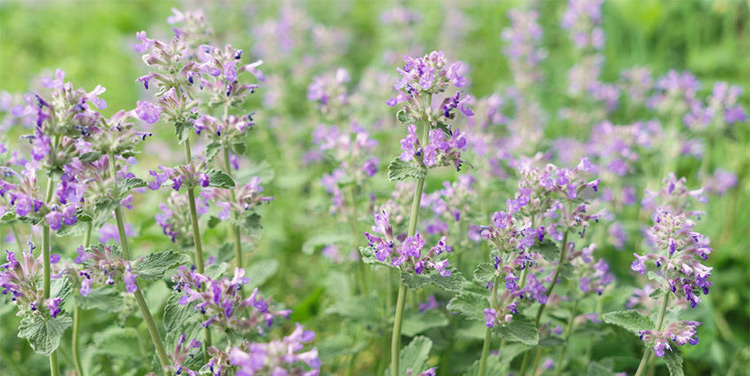Catnip Essential Oil
Nepeta cataria

The common names catnip and catmint are sometimes, but not always, used interchangeably to refer to Nepeta cataria.. As with all essential oils, it's important to confirm the botanical name of the essential oil that you are working with. This profile specifically pertains to Nepeta cataria.

Description
Due to its composition of the lactone nepetalactone, Catnip Essential Oil is most highly regarded for its potential as a mosquito repellent. If I am interpreting Dr. Buckle's comment correctly, Catnip Essential Oil is also the nepetalactone that is responsible for catnip's attraction to cats. (The citation applies to Nepeta parnassica, but Nepeta cataria is also comprised of up to 84% nepetalactone. [Source: Gkinis G., Michaelakis A., Koliopoulos G., Ioannou E., Tzakou O., Roussis V., Evaluation of the repellent effects of Nepeta parnassica extract, essential oil and its major nepetalactone metabolite against mosquitoes. Parasitol Res. PMID: 24449446. Accessed January 27, 2014. As cited in Jane Buckle, PhD, RN, Clinical Aromatherapy: Essential Oils in Healthcare (Third Edition. United Kingdom: Churchill Livingstone Elsevier, 2015), 54.]
Catnip Essential Oil Benefits and Uses
- Anti-Microbial
- Antiseptic
- Anti-Spasmodic
- Congestion
- Mosquito-Repellent
Source: Neryls Purchon and Lora Cantele, Complete Aromatherapy & Essential Oils Handbook for Everyday Wellness (Toronto ON: Robert Rose, 2014), 44.
Botanical Name

Plant Family
Common Method of Extraction
Steam Distilled
Plant Part Typically Used
Color
Pale Yellow/Orange
Consistency
Medium
Perfumery Note
Middle
Strength of Initial Aroma
Medium
Aromatic Description
Catnip Essential Oil smells herbaceous with a subdued mint aroma.
Major Constituents
- Nepetalactone Isomers
- Nepetalic Acid
- Dihydronepetalactone
- B-Caryophyllene
- Caryophyllene Oxide
See Essential Oil Safety for a more complete list of typical constituents.
Source: C. Bourrel, F. Perineau, G. Michel, J.M. Bessiere, Catnip (Nepta cataria L.) Essential Oil: Analysis of Chemical Constituents, Bacteriostatic and Fungistatic Properties. (Journal of Essential Oil Research 5, 1993), 159-167. R.A. Malizia, J.S. Molli, D.A. Cardell, et al., Volatile Constituents of the Essential Oil of Nepeta Cataria L. Grown in Cordoba Province (Argentina). (Journal of Essential Oil Research 8, 1996), 565-567.N.V. Handjieva, S.S. Popov, Constituents of Essential Oils From Nepeta cararia L. N. grandiflora M.B. and N. nuda. (Journal of Essential oil Research 8, 1996), 639-643. Sources cited in Robert Tisserand and Rodney Young, Essential Oil Safety (Second Edition. United Kingdom: Churchill Livingstone Elsevier, 2014), 237.
Catnip Essential Oil Safety Information
Tisserand advises that Catnip Oil may be a skin sensitizer and to use it with caution. Reading Tisserand and Young's full profile is recommended. [Robert Tisserand and Rodney Young, Essential Oil Safety (Second Edition. United Kingdom: Churchill Livingstone Elsevier, 2014), 237.]
This essential oil poses a higher risk of causing irritation and sensitization when used in the bath. Avoid using it in the bath, even if it is solubilized/diluted.
General Safety Information
Do not take any oils internally and do not apply undiluted essential oils, absolutes, CO2s or other concentrated essences onto the skin without advanced essential oil knowledge or consultation from a qualified aromatherapy practitioner. For general dilution information, read AromaWeb's Guide to Diluting Essential Oils. If you are pregnant, epileptic, have liver damage, have cancer, or have any other medical problem, use oils only under the proper guidance of a qualified aromatherapy practitioner. Use extreme caution when using oils with children and be sure to first read the recommended dilution ratios for children. Consult a qualified aromatherapy practitioner before using oils with children, the elderly, if you have medical issues or are taking medications. Before using this or any essential oil, carefully read AromaWeb's Essential Oil Safety Information page. For in-depth information on oil safety issues, read Essential Oil Safety by Robert Tisserand and Rodney Young.
Shelf Life
Important Information About the Profiles
The essential oil information provided on AromaWeb is intended for basic educational purposes only. The references to safety information, test results, constituents and percentages is generalized information. Essential oils can vary greatly in composition. The data is not necessary complete and is not guaranteed to be accurate. The essential oil photos are intended to represent the typical and approximate color of each essential oil. However, essential oil composition and color can vary based on harvesting, distillation, age of the essential oil and other factors. Profiles for several CO2 Extracts and absolutes are included within the directory, and are denoted as such.
